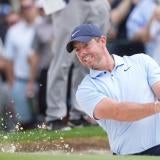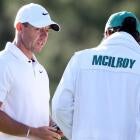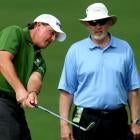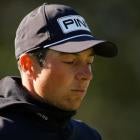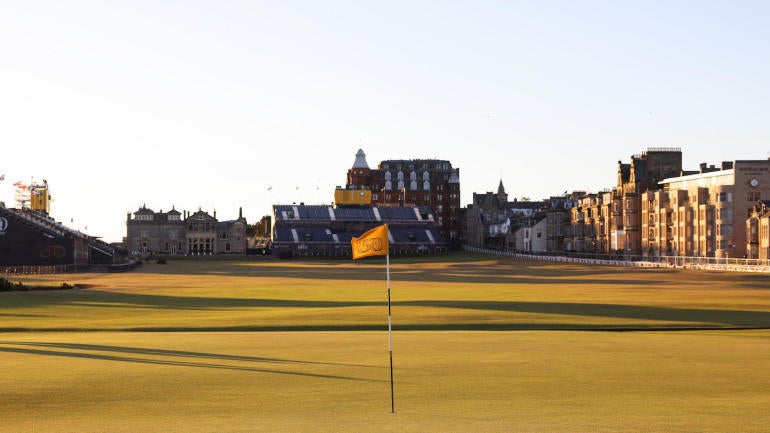
ST. ANDREWS, Scotland -- Time engenders life's deepest emotions. We look back to feel nostalgic. We look forward to feel hopeful. Time layers experiences on top of one another until traveling along this spectrum becomes overwhelming because of how much life has been lived and how much is still to come.
Without time, our experience of the world would be shallow and vapid. Because of time, it is deep and rooted. Time fertilizes our experiences until they are less a moment that happened and more a part of who we are as people.
Time is as mysterious as it is extraordinary.
At least as it relates to his play this year, 2017 Champion Golfer of the Year Jordan Spieth said Tuesday it didn't much matter to him how many Open Championships have been played throughout history.
"It's very exciting," said Spieth of the 150th Open Championship at St. Andrews. "If it were the 100th [or] 143rd ... it doesn't change anything for me on the golf course."
Though it shouldn't matter for a player whether an Open is the 26th or 78th or 123rd edition, it does matter when it comes to context because context outlines our lives. The Open matters for a thousand reasons, but one of the foremost is because it is the oldest of the most significant golf tournaments in the world. Its first edition was played in 1860, and its first trip to St. Andrews came in 1873.
"Obviously, it's the 'Home of Golf.' It's the spiritual home," Rory McIlroy told CBS Sports last week. "There's just a different feel. You stand on that first tee beside the R&A clubhouse, and you can't help but think about people playing there 150 or 200 years ago. It's special. It's different."
People were teeing off in that same spot, by that same North Sea when the United States consisted of just 37 states and the American Civil War was just eight years in the past. They teed off there for 11 different tournaments before World War I.
"It's hard to believe it's been 150 years we've played this tournament," Tiger Woods said. "And it's incredible, the history behind it, the champions that have won here. As I said, it's hard to believe it's more historic [this year], but it really is. It does feel like that. This does feel like it's the biggest Open Championship we've ever had."
One hundred fifty is an arbitrary number just like any other anniversary. It's round, and graphic designers can easily form it into a fancy logo for their marketing teams to sell. In this sport, though, it's also a reminder about what makes golf so special: Its roots run deeper than any other sport. And it has come during a year in which the sport has never needed that reminder more.
Golf was played on the links of St Andrews 200 years before electricity was discovered.
— Justin Ray (@JustinRayGolf) July 11, 2022
"The history of the game is certainly something that I've taken to heart," Woods said. "I think it's a very important part of understanding the development of our game, where we've come from, especially for me, for a person who's had to struggle at times for admittance into clubhouses or onto golf courses.
"So, I understand it from a different historical side, too, as well. But you have to appreciate everything about this game, how it's developed, and the people who have paved the way to allow us to play in these events, who created the energy behind it.
"There's so many great champions. Like yesterday for instance [at the Celebration of Champions] that were out there, I hope some of these kids who were watching at home got a chance to appreciate that, to see them playing out there. I saw Bob Charles out there on 18 hitting. I think he won in '63 or something like that. Just to be able to see that in person, live, God, it was just so special. I just hope the kids appreciate that."
Ancient artifacts are amazing, even more so when they stand the test of time. And what is a better representation of that in golf than the Old Course at St. Andrews? Yes, the R&A has had to stretch this track onto other St. Andrews courses to make it stand up against the modern game. And yes, the scoring might get silly this week. But what other course would have made it even this far?
"It's probably the most strategic golf course in the world, and yet, it was put down by the sheep," said Nick Faldo, a six-time major winner and the 1990 Champion Golfer of the Year at St. Andrews.
The Old Course has a unique link to golf fans, too. Normal fans like us can't take batting practice at Fenway Park or run routes at Lambeau Field or play five-on-five at Allen Fieldhouse. It's just never going to happen. Even in golf, especially American golf, it's rare. Most fans will never have a chance to play the courses they watch on TV.
The Old Course, though? You can play it. You can try to avoid the bunkers like Tiger, and you can try to make the putt on No. 18 like Seve Ballesteros or the one from off the green like Constantina Rocca.
St. Andrews is just a magical as you imagine. Folks tote their golf clubs around town at all hours of the night. Bars and restaurants seem to be glorified storage spaces for all kind of clubs. You might run into Keegan Bradley crossing the street or Spieth in a gym or any number of golf's power brokers, all of whom you've seen on TV.
It's the smallest big town in the sport.
It's also the place where everyone gathers to remember and to project. This week at the Old Course has been spent equal parts romantically reminiscing about everything this place has seen and wildly wondering about what LIV Golf will do to the future of the sport. A manifestation of the passage of time.
"On Sunday night, it will be my privilege to announce the Champion Golfer of the Year in the 150th staging of this wonderful championship," said R&A CEO Martin Slumbers while looking forward to the highlights of the week. "That player will have his name carved in history on the Claret Jug, and what could be more special than that?
"I would urge you all to keep that in mind and enjoy The Open as much as we will. It will certainly be an occasion to tell your children and your grandchildren about for many years to come."
These events are but a wisp. Nearly 8,000 weeks have passed since St. Andrews hosted its first Open Championship. Opens on this course have been played on just 0.37% of the weeks since then. Another one won't be played at St. Andrews for at least five more years. Rory McIlroy will be nearly 40 years old. Phil Mickelson will be inching toward 60. Time will have accumulated more layers.
The more time passes, the more we appreciate what's around us. This is true both internally and externally. As we age, we become more grateful for the people in our lives and the places we get to visit and the things we get to see. In the same way, as external entities age, they become more wondrous. People may gawk at the incredulity of modern skyscrapers, but the 12th century castles that dot all of Scotland generate dreams.
What's happening this week at the Old Course at St. Andrews cannot be engineered or manufactured. You cannot throw enough money at another event to try and match what's taking place at this Open. You cannot purchase time. That's a refreshing reality in a golf world in which it seems like everyone and everything has a price.
So, while 150 is only a number, it's also much more. At dusk on Sunday evening, 155 golfers will have to wait at least five more years to have a rip at the Old while one will kiss a jug that's nearly as old as the tournament itself.
And there's no doubt, when the 2022 Champion Golfer of the Year glances at the names and the years adorning the best trophy in sports, something inside him will crack and spill over.
Time engenders life's deepest emotions, and this Open is nothing if not a reminder of time.
![[object Object] Logo](https://sportshub.cbsistatic.com/i/2020/04/22/e9ceb731-8b3f-4c60-98fe-090ab66a2997/screen-shot-2020-04-22-at-11-04-56-am.png)







